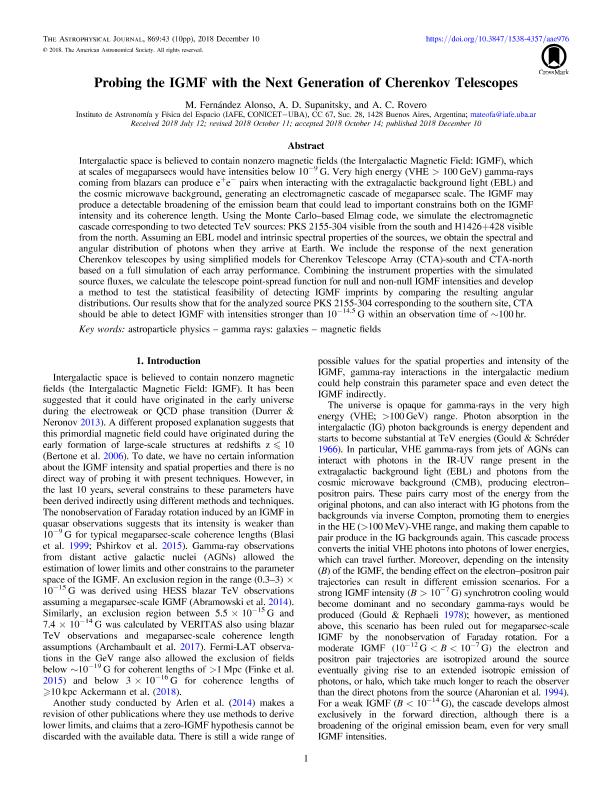Artículo
Probing the IGMF with the Next Generation of Cherenkov Telescopes
Fecha de publicación:
12/2018
Editorial:
IOP Publishing
Revista:
Astrophysical Journal
ISSN:
0004-637X
Idioma:
Inglés
Tipo de recurso:
Artículo publicado
Clasificación temática:
Resumen
Intergalactic space is believed to contain nonzero magnetic fields (the Intergalactic Magnetic Field: IGMF), which at scales of megaparsecs would have intensities below 10-9 G. Very high energy (VHE > 100 GeV) gamma-rays coming from blazars can produce e+e- pairs when interacting with the extragalactic background light (EBL) and the cosmic microwave background, generating an electromagnetic cascade of megaparsec scale. The IGMF may produce a detectable broadening of the emission beam that could lead to important constrains both on the IGMF intensity and its coherence length. Using the Monte Carlo-based Elmag code, we simulate the electromagnetic cascade corresponding to two detected TeV sources: PKS 2155-304 visible from the south and H1426+428 visible from the north. Assuming an EBL model and intrinsic spectral properties of the sources, we obtain the spectral and angular distribution of photons when they arrive at Earth. We include the response of the next generation Cherenkov telescopes by using simplified models for Cherenkov Telescope Array (CTA)-south and CTA-north based on a full simulation of each array performance. Combining the instrument properties with the simulated source fluxes, we calculate the telescope point-spread function for null and non-null IGMF intensities and develop a method to test the statistical feasibility of detecting IGMF imprints by comparing the resulting angular distributions. Our results show that for the analyzed source PKS 2155-304 corresponding to the southern site, CTA should be able to detect IGMF with intensities stronger than 10-14.5 G within an observation time of ∼100 hr.
Palabras clave:
ASTROPARTICLE PHYSICS
,
GAMMA RAYS: GALAXIES
,
MAGNETIC FIELDS
Archivos asociados
Licencia
Identificadores
Colecciones
Articulos(IAFE)
Articulos de INST.DE ASTRONOMIA Y FISICA DEL ESPACIO(I)
Articulos de INST.DE ASTRONOMIA Y FISICA DEL ESPACIO(I)
Articulos(ITEDA)
Articulos de INSTITUTO DE TEC. EN DETECCION Y ASTROPARTICULAS
Articulos de INSTITUTO DE TEC. EN DETECCION Y ASTROPARTICULAS
Citación
Fernandez Alonso, Mateo; Supanitsky, Alberto Daniel; Rovero, Adrian Carlos; Probing the IGMF with the Next Generation of Cherenkov Telescopes; IOP Publishing; Astrophysical Journal; 869; 1; 12-2018; 1-10
Compartir
Altmétricas




